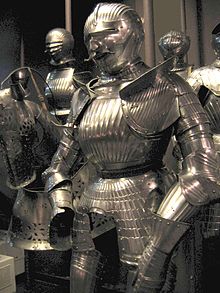- Maximilian armour
-
Maximilian armour is a modern term applied to the style of early 16th-century German plate armour apparently first made for the Emperor Maximilian I. The armour is characterized by armets and close helmets with bellows visors; small fan-shaped narrow and parallel fluting—often covering most of the harness (but never the greaves); etching; work taken from woodcuts; sharply-waisted cuirasses, and squared sabatons.
According to an alternative version, the name is related to Maximilian II, as the last Maximilian armour was made especially for him in 1557, seventeen years after it passed out of general use.[1]
The armour was designed to imitate the pleated clothing that was considered fashionable in Europe at the time. A trend that developed in 15th-century Europe was to create armour that not only provided the maximum amount of protection, but was also visually pleasing. Maximilian armour combined the rounded Italian style of armour with the German fluted style.
Contents
About the term
Not every armour worn by Maximilian I was a Maximilian-style armour. The most famous armour worn by Maximilian was gothic-style armour, which was worn by Maximilian when he was a young prince and later presented as an honourable wedding gift for his uncle Sigmund.[2] Maximilian I became emperor in 1493 and died in 1519, but classic Maximilian armours are known from 1515 to 1525, and similarly-shaped armour with less or different fluting was produced from 1500.[3]
Transitional Schott-Sonnenberg style
Early types of Maximilian armour with either no fluting or wolfzähne (wolf teeth) style fluting (which differs from classic Maximilian fluting) and could be worn with a sallet are called Schott-Sonnenberg Style armour by Oakeshott.[3] This transitional armour was worn from 1500 to 1520, and true Maximilian armour was worn from 1515 to 1525. Some other historians do not fully separate Schott-Sonnenberg style from Maximilian armour.
Italian "alla tedesca" (a la german) armour
Italian "alla tedesca" ("a la german") armour is an Italian armour of 1500–1515 with fluting and the Maximilan breast shape. Knee-long tassets were often worn with a bellows-visored sallet. This kind of armour is considered by Oakeshott to be a kind of Schott-Sonnenberg Style armour made by Italians for the German market.[3]
Parallels with late (rounded) kastenbrust armour
It is interesting to find that the cuirass-shape of the Schott-Sonnenberg style was foreshadowed in Germany half a century before it finally appeared. Several tomb effigies and paintings of 1400–1500 show extremely rounded, bulbous breastplates – as I have said (page 82), this was often an alternative to the boxed Kastenbrust style ... [3]
Such armours of the first half of the 15th century are separated by Oakeshott from kastenbrust armour as alwite armour. However, other historians consider it as a kind of kastenbrust armour.
Gallery
See also
References
- ^ Funcken, Liliane; Funcken, Fred (1983). The Age of Chivalry. Prentice Hall. ISBN 0130463183.
- ^ Robinson, Nathan. "Anatomy of Armour: Gothic Armour of the 15th Century". http://www.myarmoury.com/feature_gothic_armour.html. Retrieved 2011-09-16.
- ^ a b c d Oakeshott, R. Ewart (2000). European Weapons and Armour. from the Renaissance to the Industrial Revolution. Rochester, NY: Boydell Press. ISBN 0851157890.
Categories:- Medieval armour
- Early Modern armour
Wikimedia Foundation. 2010.






